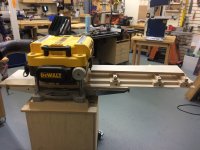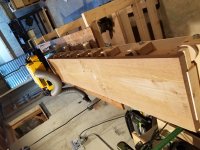ChicagoNewGuy
Member
- Joined
- May 5, 2012
- Messages
- 12
Hello everyone,
I'm hoping for some advice. I find milling lumber to be extremely difficult and I'm wondering if I'm biting off more than my tools can chew. I have a stock Dewalt D735 planer and an old Craftsman 6" jointer with 18" long infeed and outfeed tables. Many years ago, I bought gallons and gallons of rough walnut from a guy that was moving, the boards are 12" x 1 1/4" x 10'. A couple of years ago I made my first project with this lumber, a simple 20"x40" vanity. I cut the boards to length and then ripped them down to 5" wide, so they would fit in my jointer. By the end of it, I had milled the 1 1/4" boards down to 7/8" thick. It was absolute torture. My jointing produced boards that were fatter in the middle and using the planer was like pulling teeth, pushing and pulling the boards through at the end to keep them from getting stuck and burning. It made me hate my workshop for a while. I think a lot of my issue was not having long enough infeed/outfeed tables. Well now I'm about to embark on another adventure with this walnut and I need to create a 24"x70" slab as part of a piece of furniture I'm going to take a shot at. Part of me just wants to go out and buy some veneered plywood but I have all this freaking walnut that I want to use up. Today I got started by cutting a couple of boards to length and ripping them down to 6" wide. I started face jointing one of them and I'm realizing this is never going to work, it feels like it is going to be exponentially worse than the bathroom vanity.
Any advice on how to make this less painful?
Thanks,
Imran
I'm hoping for some advice. I find milling lumber to be extremely difficult and I'm wondering if I'm biting off more than my tools can chew. I have a stock Dewalt D735 planer and an old Craftsman 6" jointer with 18" long infeed and outfeed tables. Many years ago, I bought gallons and gallons of rough walnut from a guy that was moving, the boards are 12" x 1 1/4" x 10'. A couple of years ago I made my first project with this lumber, a simple 20"x40" vanity. I cut the boards to length and then ripped them down to 5" wide, so they would fit in my jointer. By the end of it, I had milled the 1 1/4" boards down to 7/8" thick. It was absolute torture. My jointing produced boards that were fatter in the middle and using the planer was like pulling teeth, pushing and pulling the boards through at the end to keep them from getting stuck and burning. It made me hate my workshop for a while. I think a lot of my issue was not having long enough infeed/outfeed tables. Well now I'm about to embark on another adventure with this walnut and I need to create a 24"x70" slab as part of a piece of furniture I'm going to take a shot at. Part of me just wants to go out and buy some veneered plywood but I have all this freaking walnut that I want to use up. Today I got started by cutting a couple of boards to length and ripping them down to 6" wide. I started face jointing one of them and I'm realizing this is never going to work, it feels like it is going to be exponentially worse than the bathroom vanity.
Any advice on how to make this less painful?
- Is my issue not enough infeed and outfeed space? I feel like guys on YouTube just send 8ft boards through their machines and catch them on the other side no sweat. This would be a lot of effort for me and my shop is small. Are rollers as good as extension tables?
- Are my tools too small, am I expecting too much from them?
- Instead of trying to mill (4) 6" x 70" boards should I try a brick pattern and mill up a bunch of 6"x24" boards? Or would chopping up these long beautiful walnut boards into tiny pieces be sacrilegious?
- Would my life be easier if I re-sawed the lumber in half to 5/8 thick boards that might be easier to handle?
Thanks,
Imran



